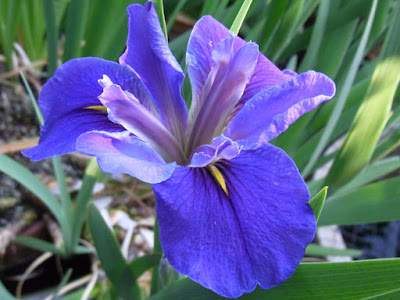It seems like it was only weeks ago that I posted a blog about my newly planted little "Cutecumber" cucumber plants. And that's because it was only four weeks ago! My, how this thing has grown in our summer sunshine, and now it is producing Lebanese type cucumbers at an astonishing rate. Right now, I'm bringing in two cucumbers a day, and though Pammy is a world-class cucumber snacker, she's falling behind and the cucumber glut in our fridge crisper cabinet is growing.
The plant's label said "90-150cm" but I think that's the daily growth rate ...
Mind you, it's a handsome thing right now. A month from now, as February's deadly, oppressive humidity starts to hit, this lovely green foliage will probably be dusted with powdery mildew, despite my best organic efforts to prevent it.
Half the trick with harvesting the cucumbers is actually finding all of them. The plant's growth is so lush, meandering and complex that it's easy to miss fairly large cucumbers. Our lunch guests on Christmas Day managed to spot three cucumbers I hadn't noticed.
With all this excess produce mounting up (even after giving several away) there was only one way to cope: make pickles. And so that's what I did today. I've made two different types of pickles. One is a Sweet Danish Pickle which I've made a few times before and which I really like. The other is my first attempt at dill pickles. It's too early to know whether that batch has worked, so stay tuned.
In the meantime, here's the basics of the Danish Sweet Pickles ...
After washing three cucumbers, finely slice them. That white thing in the photo is a Zyliss slicer, which is hellishly nerve-wracking to use because it's so sharp, but if you are very careful and follow the safety guidelines, it makes quick work of three little cucumbers. Each slice is very thin, about 1-2mm.
As you transfer the slices to a bowl, sprinkle over some sea salt flakes. I added the cucumbers in about 3 layers, salting each layer as I went. Leave them to soak for 10-15 minutes.
Meanwhile, make the pickling liquid, which is 1.5 cups white wine vinegar, half a cup of sugar, 5 bay leaves, 1 teaspoon yellow mustard seed, and 1 teaspoon of whole black peppercorns. To mix this up, just add the sugar to the vinegar in a few batches, stirring with a fork until the sugar dissolves. No heat is necessary, and the whole thing takes about 1 minute. So easy!
Next, rinse the salted cucumber slices under running water to remove the salt, drain in a colander, then gently squeeze dry. Divide the cucumbers into two small, sterilised jars, or pop them into one large sterilised jar.
Next, add the pickling liquid, along with the bay leaves and spices, to each jar (if using two). Seal the lids, pop them into the fridge and they are ready to eat by the evening (presuming you made them in the morning). Talk about easy.
If you think half a cup of sugar is way too much, the original recipe used one whole cup of sugar. I've experimented with 1/3 cup, 1/4 cup and I think 1/2 cup suits my tastebuds.
The original use for these pickles is as a "pickled cucumber salad" (agurk salat) to go with Danish pork and veal meatballs, called Frikadellers. While I still use them for that dish, these pickles are wonderful as part of lunchtime sandwiches, too.
Finally, the big experiment that has yet to end ... my first attempt at classic dill pickles. Now, the first thing I have learnt about this recipe is that there are only about a zillion dill pickle recipes out there (all authentic, of course).
The second thing I've learnt is that there is such a thing as "refrigerator" dill pickles, which means you can make up a little batch in a jar and pop them in the fridge. Wait a few days and they should be ready.
I am definitely not ready for Advanced Industrial Pickling yet — with all those scary jars with exploding sealed lids sitting in big pans of boiling water. So I like this idea of "refrigerator" dill pickles, it's far more peaceful. Here's what I did.
Sterilise the jar in boiling water, and wash three cucumbers. Slice off the ends of each cucumber, then slice lengthways into batons that are about one inch shorter than the jar.
Next, make up the pickling liquid, which is 1.5 cups water mixed with 1.5 cups apple cider vinegar, 2 tablespoons sea salt flakes, and 1 teaspoon sugar. Add this to a saucepan, heat this until the sugar and salt have dissolved, let it come to a gentle simmer, then turn off the heat and leave it all for half a hour to cool down.
To the bottom of the jar, add 1 peeled clove garlic, a sprig fresh dill and 1 teaspoon pickling spices mix (these are sold here in Oz in packs which contain mustard, peppercorns, allspice and dill seed). Then carefully stuff the jar full of cucumber batons.
By the way, there is an alternative method for making these same refrigerator pickles, and the main difference is that you pour the very hot, simmering pickling liquid into the packed jar of cucumbers, then you let that cool down completely before refrigerating the jar. I wouldn't have a clue if that works, but I suspect it does because there's half a zillion recipes online which say to do it that way.
In the meantime, I hope 2017 is a very much better year for you than 2016 was, and I look forward to letting you know the exciting conclusion to my pickling experiments early in the New Year. See you then!




















































